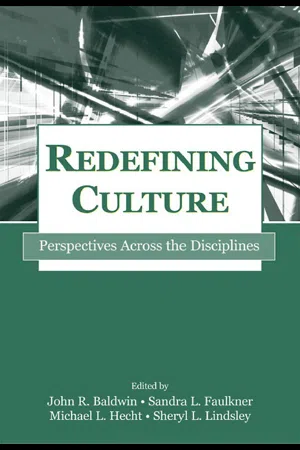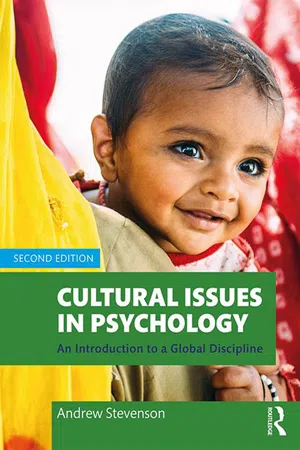Social Sciences
Concept of Culture
Culture refers to the shared beliefs, values, customs, and behaviors of a particular group of people. It encompasses language, traditions, art, and social norms that shape the way individuals within a society interact and perceive the world. Culture is dynamic and can evolve over time, influenced by historical, environmental, and social factors.
Written by Perlego with AI-assistance
Related key terms
5 Key excerpts on "Concept of Culture"
- eBook - ePub
Redefining Culture
Perspectives Across the Disciplines
- John R. Baldwin, Sandra L. Faulkner, Michael L. Hecht, Sheryl L. Lindsley(Authors)
- 2006(Publication Date)
- Routledge(Publisher)
“Culture is shared, learned behavior which is transmitted from one generation to another for purposes of promoting individual and social survival, adaptation, and growth and development. Culture has both external (e.g., artifacts, roles, institutions) and internal representations (e.g., values, attitudes, beliefs, cognitive/affective/sensory styles, consciousness patterns, and epistemologies.” (pp. 166–167)Marshall, G. (1994). The concise Oxford dictionary of sociology.NewYork: Oxford University.“In social science, culture is all that in human society which is socially rather than biologically transmitted, whereas the common sense usage tends to point only to the arts. Culture is thus a general term for the symbolic and learned aspects of human society, although some animal behaviorists now assert that certain primates have at least the capacity for culture.” (p. 104)Martin, D. (1970). Fifty key words in sociology. Richmond, VA: John Knox.“The culture of a people consists not only of its concrete creations—tools, buildings, and so on are its ‘material culture’—but of all the patterns of interaction, all the formal and informal rules of behavior which have become traditional in the relations between social groups and between the incumbents of standardized roles.” (p. 15)“In sociology, perhaps because it has concentrated on larger and more obviously structured societies, the tendency has been to use ‘social structure’ or ‘the social system’ as the fundamental concept and to restrict the term ‘culture’ to only one contributory element in the social whole. ‘Culture’ normally means continuities of values and taste which have been traditional in a society. To a sociologist, ‘culture’ often denotes something very close to ‘life style,’ the common values, the aesthetic, moral, emotional and intellectual preferences which find expression in the social behavior of a group or society.” (p. 15)Martin, J. (2002). Organizational culture: Mapping the terrain. Thousand Oaks: Sage.Martin provides an entire chapter of discussion as to what organizational culture is and is not, calling the definition of culture the “granddaddy” of dilemmas (p. 55). She outlines three traditions of defining culture: functionalism, critical theory, and postmodernism. Definitions focusing on the structure of understandings or meanings (“cognitive aspects of culture”) are ideational, whereas materialist - eBook - ePub
Culture and Project Management
Managing Diversity in Multicultural Projects
- Omar Zein(Author)
- 2016(Publication Date)
- Routledge(Publisher)
Chapter 1
Elements of Culture
Defining Culture
It is worth taking a moment to be precise about the meaning of the term ‘culture’. ‘The ideas, customs, and social behaviour of a particular people or society.’ Oxford Dictionary ‘The way of life, especially the general customs and beliefs, of a particular group of people at a particular time.’ Cambridge Dictionary ‘The beliefs, customs, arts, etc., of a particular society, group, place, or time.’ Merriam-Webster Dictionary These dictionary definitions, which are largely in tune with one another, highlight the following: • Culture is not born out of the individual. It is born out of the group. • Culture encompasses a number of people who were conditioned by the same education and life experiences. • Culture is the collective ‘conditioning’ of a given group, a tribe, a community or a nation which is different from that of other groups, tribes and communities.Let’s take a historical example: a simple agricultural society that once lived happily and peacefully until the arrival of invaders that repeatedly threatened their land, crops, livestock and their life. The members of this simple society started to explore ways to counter such threats, and came to structure themselves in a way that allowed them to fight off the invaders. They trained their men to become strong and learn the art of fighting. They gave more importance and respect to individuals who showed leadership and strategic vision. And soon, they developed a hierarchical structure of strong young men and wiser old men, who together established how to defend the society. The older men were the leaders, the younger strong men were the field fighters and defenders who underwent regular training. - eBook - ePub
Cultural Issues in Psychology
An Introduction to a Global Discipline
- Andrew Stevenson(Author)
- 2020(Publication Date)
- Routledge(Publisher)
Herskovits, 1948 ]) that distinguish one social group from another. Whatever culture is, then, it is certainly what renders one group different from others.Figure 2.1 Everyday ways of talking about ‘culture’Short of striving for a single definition of culture, Berry et al. (2011) aid our understanding of the term by arguing that it is an idea that seeps into six areas of our lives. For them, when I talk about my culture I speak of my social group’s:- History and traditions – e.g. Midwinter celebrations are a tradition in my culture .
- Conventions and norms – e.g. It’s conventional here to kiss both cheeks when greeting .
- Activities and behaviours – e.g. Music, dancing and sport are some of our favourite pastimes .
- Institutions and organisational infrastructure – e.g. The separation of Church and state is part of our culture .
- Biological ancestry – e.g. Our ancestry dates back centuries .
- Psychological characteristics – e.g. Modesty, pride and co-operation are part of our shared personality traits.
It is interesting to note how these six contexts for culture encompass elements of both ethnicity (shared identity) and race (biological ancestry), as they are described in Table 2.1 . This highlights the overlapping nature of all these concepts. Part of the reason why it is so hard to see where culture ends and nation and ethnicity begin is that these labels refer to phenomena that are partly intangible and unobservable, such as feelings of belonging or ‘psychological dispositions of different groups’. Triandis (2002) acknowledges this when distinguishing between material and subjective aspects of culture. The former refers to the visible, shared characteristics of my group: how we dress, our defining technologies, our favourite cuisine. Subjective culture encompasses the invisible yet influential ideas and values that my social group deems sufficiently valuable to pass on to future generations (through a process known as cultural transmission ). These may include moral codes, religious doctrines and social etiquette. According to this formulation, when most people in a social group (from a particular region or time period) share these material and subjective elements, we have what is known as a cultural group, or culture . Such a group may or may not also share a national identity (Japanese culture ), an ethnic identity (Latino culture ) or even a particular occupation or interest (student culture , drug culture , counter-culture - eBook - ePub
Crossing Cultures
Insights from Master Teachers
- Nakiye Avdan Boyacigiller, Richard Alan Goodman, Margaret E. Phillips(Authors)
- 2004(Publication Date)
- Routledge(Publisher)
Part IIFraming the culture concept: What is culture?/How can we characterize it?
A fundamental principle of this book is to permit “definitional robustness” to inform our collective appreciation. Each author was requested to identify their own definition of culture as part of the module they were writing about. True to this principle we have created as the first part a series of teaching modules that come from different perspectives and that engage in the adaptation of their perspectives to teaching about culture and culture’s impact within organizations and between organizations.Goto and Chan bring to bear a social-psychological perspective that bridges between the individual and the cluster of individuals. By starting with individually generated data they easily show a class where the clusters of shared values exist. This is a powerful and easily presented technique that supports the idea that “there is a difference” at the values level and is a powerful starting point for the exploration of these differences.We have asked Mary Yoko Brannen to explicate how she as a trained social anthropologist selects from, adapts, and transitions the basic issues of her field into a most valuable lesson at the organizational level. Thus, she challenges the static and monocultural assertions of many and argues for dynamic and multicultural assumptions as more relevant to organizational life.Sackmann and Phillips offer a “multiple cultures” view of organizational life, a developing perspective in the field of international cross-cultural management. They provide a practical process for discussion of this perspective, one that has been used successfully both with students at various academic levels and with practitioners. Here, the focus is on heightening the learners’ awareness of the multiple cultures carried both by individuals and by organizations and deepening their understanding of the impact of these multiple cultures within work settings. - eBook - ePub
Concepts and Categories
Foundations for Sociological and Cultural Analysis
- Michael T. Hannan, Gaël Le Mens, Greta Hsu, Balázs Kovács, Giacomo Negro, László Pólos, Elizabeth Pontikes, Amanda J. Sharkey(Authors)
- 2019(Publication Date)
- Columbia University Press(Publisher)
Second, having recognized that concepts generally get socially constructed, it becomes important to consider the extent to which meanings diverge or coalesce across individuals and groups. Shared concepts enable communication and coordination between people; in that sense, conceptual agreement is fundamental for creating and maintaining a social order. But most concepts are neither universally agreed upon nor entirely unique to each individual. Rather, there tends to be more consensus on concepts within communities and more divergence across communities. Some would say that such clumping of concepts marks what it means for knowledge to be cultural. This aspect of conceptual knowledge leads scholars to attend to questions of how and when consensus will arise and, likewise, when divergent meanings will persist, as well as to the consequences of either consensus or divergence (DiMaggio, 1987).Finally, many of the concepts that are most interesting from a sociological standpoint are laden with value (Douglas, 2008 [1966]). That is, a particularly consequential facet of concepts is that they often become infused with a moralistic or evaluative dimension, as Selznick (1957) claimed applies to the elements of formal organization. When concepts have positive or negative valence, these valuations extend to persons, situations, and objects through the process of categorization. This means that categorization can generate affective reactions and potentially profound social consequences. Consider, for example, the use of the concept developing countries to refer to nations with lower- and middle-income levels. The World Bank recently banned the use of this term in its flagship data publication, in part because it was increasingly interpreted as implying that such countries were inferior to so-called developed nations (Kenny, 2016).1.1 Toward a Sociology of Concepts and CategoriesWithin sociology, foundational work by Goffman (1963) and Berger and Luckmann (1966) drew early attention to the importance of concepts and categorization in enabling everyday social interaction. Today several core subfields within sociology are defined by their focus on particular concepts—gender, race, social class, occupation. But much less attention has been paid to how concepts operate more generally
Learn about this page
Index pages curate the most relevant extracts from our library of academic textbooks. They’ve been created using an in-house natural language model (NLM), each adding context and meaning to key research topics.




